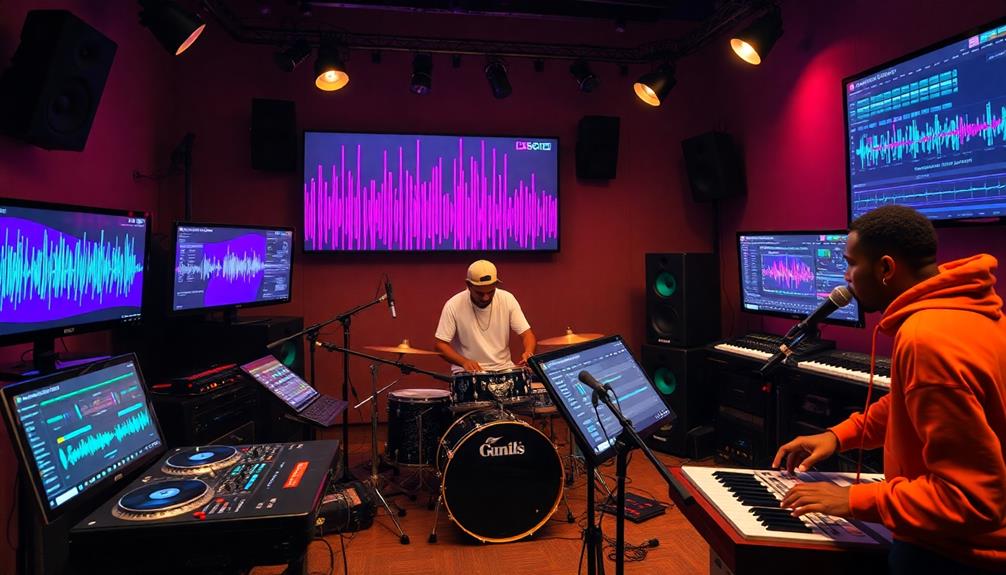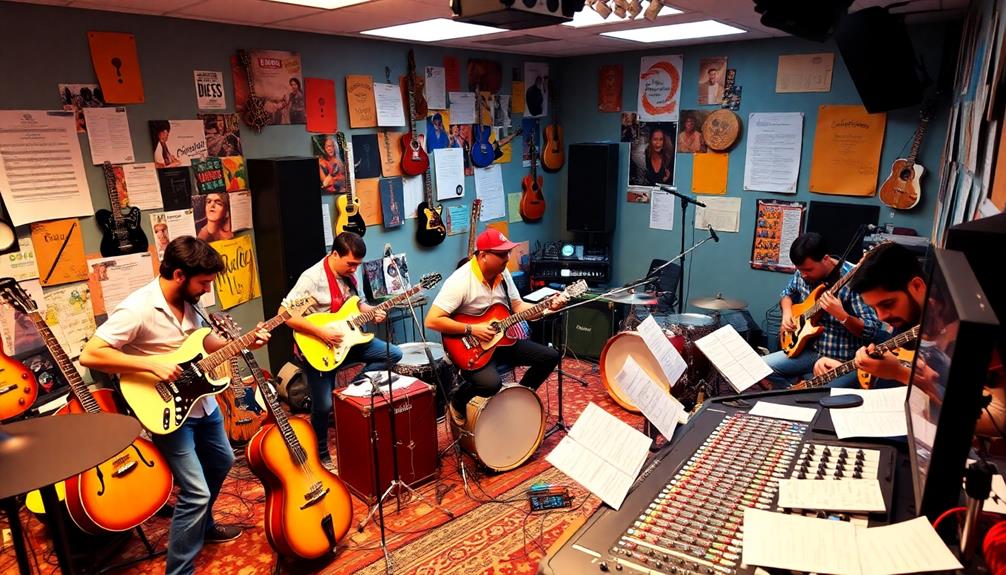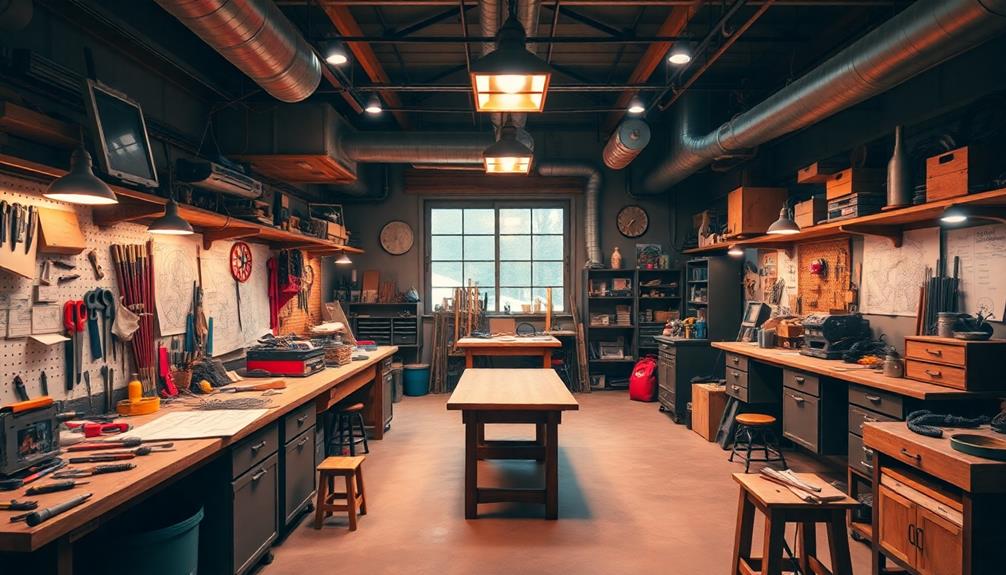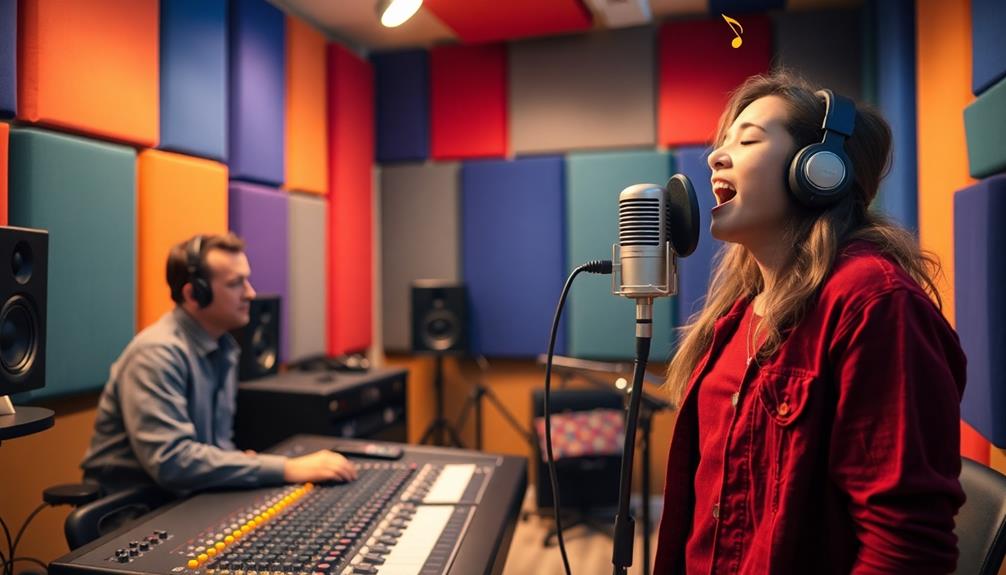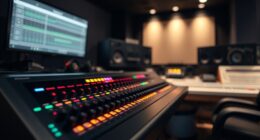To build beats like the pros, you need to understand hip-hop beat structure, which typically includes an Intro, Verse, Hook, Bridge, and Outro. Start by setting a solid drum pattern, usually an 8-bar loop. Experiment with rhythm patterns and incorporate variations to keep listeners engaged. Play around with different genres, like Trap or Boom Bap, to find your unique sound. Use quality gear and technology, like a reliable DAW and MIDI controller, for best results. By mastering these elements, you'll create polished beats that stand out. Keep exploring to discover even more production tips and tricks!
Key Takeaways
- Understand the essential components of hip-hop beats: Intro, Verse, Hook, Bridge, and Outro for structured compositions.
- Experiment with various hip-hop sub-genres like Boom Bap, Trap, and Lo-Fi to develop a unique sound.
- Utilize quality equipment and software, including a DAW and MIDI controllers, to enhance your beat production process.
- Apply effective mixing techniques, such as EQ and compression, for a polished and professional sound.
- Monetize your beats through platforms like Beatstars, streaming services, and social media to reach potential buyers.
Understanding Hip-Hop Beat Structure

When you immerse yourself in hip-hop, understanding the beat structure is essential for creating tracks that resonate. Hip-hop beat making typically follows a dynamic arrangement, featuring key sections like the Intro, Verse, Hook (Chorus), Bridge, and Outro. This structure allows you to engage listeners effectively.
For verses, an 8-bar drum loop is common, while hooks often utilize a contrasting 4- or 8-bar section, making your music production catchy and memorable.
Rhythm is critical—hip hop producers often rely on a four-on-the-floor kick pattern, with snare hits on the second and fourth beats. This establishes a strong groove that hooks the audience. You can enhance your tracks by varying drum patterns and instrumentation across sections, keeping the energy high and the listener's interest piqued.
Don't forget about fills and shifts; they're essential for creating a cohesive flow. With effective melody elements and bass lines, you'll transform your beat from a collection of sounds into a complete musical journey. By mastering these components, you'll craft beats that not only stand out but also resonate deeply with your audience.
Key Genres in Beatmaking
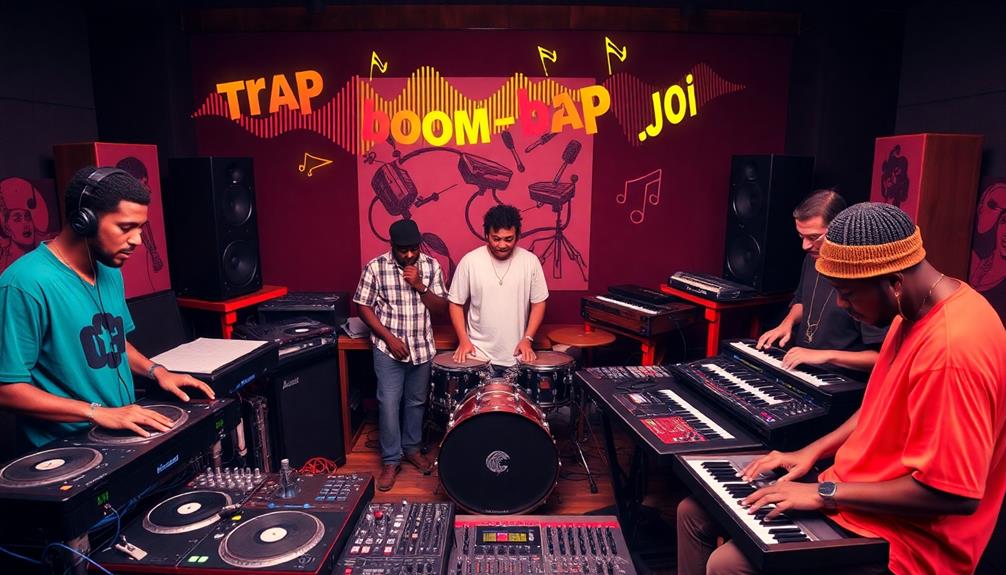
When you explore key genres in beatmaking, you'll find that popular Hip-Hop sub-genres like Boom Bap and Trap each bring unique characteristics to the table.
Understanding their distinct vibes and BPM ranges can really shape the beats you create.
Popular Hip-Hop Sub-genres
Hip-Hop is a diverse genre, teeming with sub-genres that each bring their own unique flavor to beatmaking. One of the most influential styles is Boom Bap, characterized by hard-hitting drums and a heavy reliance on samples. Emerging in the 1990s, it laid the groundwork for many hip hop beats you hear today.
Fast forward to the early 2000s, and Trap takes center stage with its rapid hi-hats and heavy bass lines, quickly becoming the most popular style in modern Hip Hop.
Then there's Drill, which burst onto the scene in Chicago during the early 2010s. This sub-genre features dark, aggressive beats and syncopated hi-hats, often reflecting intense lyrical themes.
If you're looking for something more chill, Lo-Fi is your go-to, blending jazz influences with ambient sounds for a relaxed, nostalgic vibe.
Finally, Crunk, originating from the Southern U.S., is known for its high-energy beats and call-and-response style, perfect for parties.
Understanding these popular sub-genres will enhance your approach to making beats and inspire your creativity as you craft your own unique sound.
Beat Characteristics Overview
While exploring the various key genres in beatmaking, you'll quickly notice that each one boasts its own set of defining characteristics that shape the overall sound and feel of the music. In the domain of Hip-Hop, you'll encounter diverse styles like Boom Bap, Trap, and Lo-Fi, each with unique tempos and emotional tones.
Additionally, just as celery juice is known for its anti-inflammatory properties, the right beat can evoke strong emotional responses, making the choice of genre essential. Trap beats, currently dominating the scene, typically range from 130-180 BPM and emphasize intricate drum patterns, heavy hi-hats, and booming 808s. In contrast, Boom Bap captures a classic vibe, using slower tempos of 80-100 BPM with hard-hitting drum kicks and soulful, sample-based beats.
Meanwhile, Lo-Fi offers a relaxed feel, characterized by 60-90 BPM, warm textures, and nostalgic elements like vinyl crackle.
Additionally, you can't overlook genres like Reggaeton and Afrobeats, which introduce unique rhythmic patterns and cultural influences, further enriching the landscape of modern music production.
Understanding these beat characteristics helps you craft different sections for your tracks, ensuring your beats resonate with listeners across various music genres. Embrace these elements, and you'll elevate your beatmaking skills to a professional level!
Essential Equipment for Producers

When you're getting into beat production, having the right tools is non-negotiable.
You'll need a powerful computer, a solid DAW, and MIDI controllers to make your creative process smoother.
Plus, don't forget quality sound representation with good monitors or headphones to guarantee your beats sound great everywhere.
Key Production Tools
Every producer knows that having the right tools can make all the difference in crafting high-quality beats. A reliable Digital Audio Workstation (DAW) is vital for recording, editing, mixing, and mastering your tracks. Popular options like Pro Tools, Ableton Live, and FL Studio cater to various needs. These DAWs offer a range of features, but many producers overlook the power of workflow customization. By leveraging the ultimate DAW template hack, you can streamline your creative process, saving valuable time and maintaining focus on the music. Setting up templates tailored to your style ensures you have all your go-to instruments, effects, and settings ready to go from the moment inspiration strikes.
Pair your DAW with MIDI Controllers, such as the AKAI MPK Mini or Novation Launchpad Mini, to enhance playability and allow for more expressive input.
Don't underestimate the power of a well-stocked samples and loops library. Platforms like Soundtrap offer over 25,000 royalty-free sounds, providing invaluable resources for your beat creation.
For mixing and mastering, invest in quality studio monitors to guarantee accurate sound representation. An audio interface, like the Focusrite Scarlett series, is also essential for reducing latency during recording.
If you want to take your production to the next level, consider incorporating beatmaking hardware like the AKAI MPC or Roland SP-404. These standalone devices can enhance your process but often work best alongside a DAW for all-encompassing mixing capabilities.
With these key production tools, you're well on your way to crafting professional-sounding beats.
Essential Software Choices
Choosing the right software is as important as having the right hardware in your beat-making setup. Start with a reliable Digital Audio Workstation (DAW). Popular choices like Pro Tools, Ableton Live, FL Studio, Cubase, and Logic Pro each offer unique features for recording, editing, and mixing your beats.
Selecting the right DAW can streamline your workflow and enhance your creativity. Additionally, consider how different DAW interfaces can impact your productivity and creative process, as fresh UI examples can greatly improve user experience.
Next, incorporate MIDI controllers such as the AKAI MPK Midi or the Novation Launchpad Mini. These tools enhance your playability and allow you to input notes and control parameters more intuitively, making your beat-making experience more engaging.
Don't forget about an audio interface, like the Focusrite Scarlett series. This investment reduces latency during recording and improves sound quality, which is vital for music producers aiming for professional results.
To guarantee your beats sound great, high-quality studio monitors are essential for accurate sound representation during mixing.
Steps to Create a Beat

Creating a hip-hop beat involves several essential steps that set the foundation for your track. First, you'll want to set the tempo and vibe, which typically ranges from 80-100 BPM in hip-hop. This choice impacts the overall character of your beat.
Next, sequence a strong drum pattern. Tools like Soundtrap's Patterns Beatmaker can help you establish this vital foundation.
Once your drum pattern is locked in, build your chord progressions to provide harmonic support. This will guide the development of your melody and bass line.
With those elements in place, it's time to add a catchy melody on top of your existing layers. A memorable melody can enhance the emotional depth of your beat.
Mixing Techniques for Polished Sound

Mixing techniques play an important role in achieving a polished sound for your hip-hop beats. Don't wait until the final stage to start mixing; incorporate it throughout your beat creation process. This way, you'll guarantee your tracks blend seamlessly.
Understanding the nuances of different sound profiles can greatly enhance your production, similar to how French Press Brewing emphasizes the significance of technique in coffee preparation.
Here are some key techniques to enhance your mixing skills:
- Use EQ thoughtfully: Carve out space for each instrument to improve clarity and avoid muddiness. This helps each element shine.
- Apply compression: Control the dynamics of your tracks to balance volume levels, giving your beat a more professional presence.
- Experiment with effects: Add reverb and delay to create depth, but use these effects sparingly to maintain clarity.
Always keep an eye on your track levels to prevent clipping, which can lead to distortion. A clean mix is crucial for a professional sound.
Sound Design and Enhancement

Sound design is the backbone of enchanting hip-hop beats, transforming basic sounds into dynamic auditory experiences. To achieve this, start by utilizing filtering techniques like High Pass and Low Pass filters. These help manage frequencies, enhancing mix integration for a clean mix.
Incorporate effects plug-ins such as reverb and delay to add depth and space to your samples, making the listening experience more immersive without cluttering the mix.
Compression is another vital tool in your sound design arsenal. It improves instrument clarity, but be careful not to over-compress, as this can diminish the dynamic range of your beat. Instead, focus on creating variations of samples to enrich that dynamic range, keeping your listeners engaged throughout the track.
Lastly, remember that while effects plug-ins can enhance your sound, achieving a clean mix should always be your priority. By meticulously managing your sounds and employing these techniques, you'll create beats that not only resonate but also captivate your audience.
Embrace the art of sound design, and watch your hip-hop beats transform into professional-level productions.
Monetizing Your Beats

In the competitive world of hip-hop production, monetizing your beats is essential for turning your passion into profit.
With the rise of online platforms like Beatstars, you can easily sell your beats directly to artists and musicians, expanding your reach in the market.
High demand for instrumental beats on streaming services like Spotify means there's a lucrative opportunity just waiting for you.
To effectively monetize your beats, consider these strategies:
- Leverage social media: Showcase your work and attract potential buyers through engaging posts and collaborations.
- Network strategically: Building connections with other producers and artists can greatly enhance your visibility and lead to increased sales.
- Explore publishing deals: Signing with a publishing label can open doors to lucrative placements and collaborations.
Developing Your Unique Sound

Developing a unique sound is essential for standing out in the crowded hip-hop landscape. Music genres tend to influence each other, so don't hesitate to experiment with different styles like Boom Bap, Trap, or Lo-Fi. This creative exploration can help you create a bass and rhythm that reflects your personal flair.
Continuous practice is key; dedicate time to mastering various elements such as drum patterns, chord progressions, and bass lines.
Utilizing a diverse library of samples and loops, like the 25,000 options available on platforms like Soundtrap, can keep your music fresh and inspire new beat creations. Incorporate unique instrumentation and unexpected chord changes in your arrangements to evoke different emotions and maintain listener interest.
Don't forget the power of collaboration. Collaborating with other producers or emerging artists can lead to exciting, innovative ideas that contribute to the evolution of your personal sound.
Learning Resources for Producers
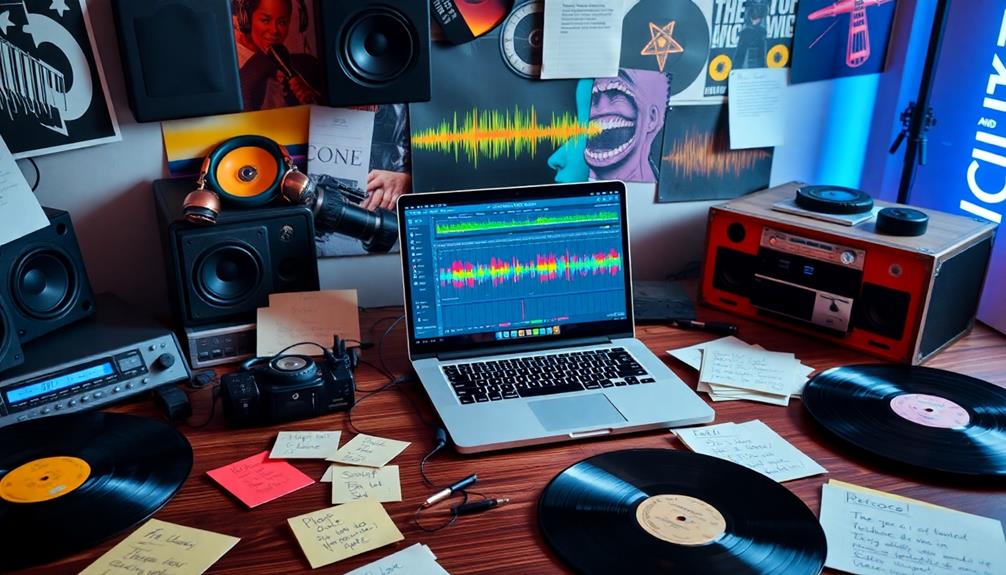
To truly refine your unique sound, tapping into the right learning resources can make a significant difference. As a producer, you want to stay ahead in the game of Hip Hop. Utilizing online tutorials on platforms like YouTube and Skillshare can help you learn how to make beats, navigate software, and master beat-making techniques.
Here are some essential resources to reflect upon:
- Online Tutorials: Platforms like YouTube are goldmines for learning everything from drum sounds to advanced production techniques.
- Community Forums: Engage with fellow producers on sites like Reddit or Gearslutz to share your work and get feedback.
- Sample Packs: Explore diverse sounds from services like Splice and BPM Create to elevate your beats and add variety.
Don't forget to read manuals and guides specific to your Digital Audio Workstation (DAW). They often contain tips that streamline your production process.
Additionally, subscription services like SoundOnSound or Produce Like A Pro provide valuable insights into the latest trends in music production, ensuring you stay informed and inspired while creating beats.
Frequently Asked Questions
How to Structure a Hip Hop Beat?
To structure a hip-hop beat, start with a solid groove using kick and snare patterns. Then, add chord progressions, create distinct sections, incorporate variations, and make certain smooth shifts to keep your beat engaging and dynamic.
What Is the Basic Beat Structure?
Picture a pulsating heartbeat: your basic beat structure includes a kick drum thumping steadily, snare snaps punctuating the rhythm, hi-hats shimmering, and a bass line grounding it all, creating a powerful groove that moves listeners.
What Is the Bar Structure of a Hip Hop Beat?
In hip-hop, you'll typically find a bar structure of 8 or 16 bars, alternating between verses and hooks. Kicks, snares, and hi-hats create a rhythmic interest, keeping your listeners engaged throughout the track.
How Do You Make Professional Hip Hop Beats?
Think of making professional hip-hop beats like cooking a gourmet dish. Start with a solid tempo, mix in strong drums, add memorable melodies, and arrange sections carefully to serve a track that's irresistible and engaging.
Conclusion
Now that you've explored the ins and outs of hip-hop beat structure, it's time to put your newfound knowledge to the test. Imagine this: you're in your studio, the beat drops, and the vibe shifts. Will your sound echo through speakers worldwide? Or will it fade into the background? The choice is yours. Embrace every step, experiment boldly, and soon, you might just find yourself crafting beats that not only resonate but captivate. The journey's just begun!

